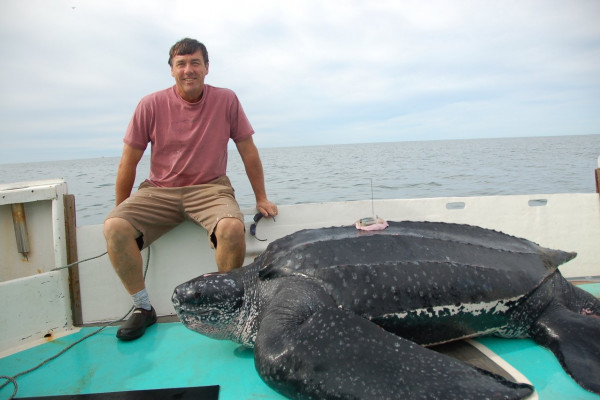
Captain Mark Leach and a rather substantially-sized friend. Photo courtesy of Kara Dodge
By Doreen Leggett
When Kara Dodge, a scientist at the New England Aquarium, began doing leatherback sea turtle research more than a dozen years ago, she turned to local fishermen for help.
“We didn’t have a lot of money so we were relying on them for access and one of the very first people who helped us get out to an entangled leatherback was Mark Leach,” Dodge remembered.
Earlier this month it was deja vu all over again. When Dodge got the season’s first call about a behemoth visitor hung up in a fish trap, Mark Leach was there yet again to assist.
Leach said this leatherback, huge at approximately 500 pounds but still about half the weight of some he’s seen, wasn’t entangled too badly. The team used the aquarium’s new inflatable platform, which fits easily on the deck of his boat, to get the turtle out of the water, unwrap the line around its flippers, and gather some data.
“We were able to attach some satellite and acoustic tags, and we let it go and it swum on its merry way,” Leach said.
Leach, and his son Sean, also a lobsterman, were among a dozen or so fishermen who turned out for a meeting at the Cape Cod Commercial Fishermen’s Alliance this spring to talk about Dodge’s new research. The Fishermen’s Alliance helped fund some of Dodge’s work on sea turtles in the past.
“I’ve been interested in turtles since I was a kid, and my first job out of college was doing hawksbill sea turtle work in Barbados,” she remembers. “But I always wanted to come home to do turtle work here in New England, and did so at my first opportunity in 2001.”
Her initial work with Leach from 2007 to 2012 involved tagging close to 30 leatherbacks to glean basic ecological information. Leach allowed the team to modify his vessel the Sea Holly (named for his son and daughter) to attach a small pulpit to the bow of the boat. The turtles were then captured in big break-away hoopnets and brought aboard.
“It’s really hard,” said Dodge, adding they made a ramp to help muscle the immense turtles (which can weigh up to a ton) onto deck.
The team catalogued details about leatherbacks’ basic ecology: how deep they dive, how long the migratory species spends in local waters, why they visit, and that they have a strong internal compass.
“To some extent everything was a surprise because almost no one had collected data in New England before,” she said. “We confirmed that these turtles are here to eat, for up to three months a year. They eat jellyfish. We do have these nice seasonal blooms of jellyfish; not nice for us, nice for the turtles.”
After several years, Dodge began to do other work with turtles, in particular a “TurtleCam” project with Woods Hole Oceanographic Institution engineer Amy Kukulya. The project involved tagging and tailing turtles with autonomous underwater vehicles to study diving behavior, eating habits, and assess ways to reduce entanglements.
This year, she and her colleagues at the Aquarium and Center for Coastal Studies are looking specifically at how leatherbacks fare after being entangled. Vertical lines from lobster, conch or other trap and pot fisheries can be a problem.
Usually the broad shouldered animals get entangled between the neck and shoulder muscles. When startled they often roll, resulting in figure eight configurations around the flippers and head. And when they tire they can drown.
Turtle entanglements can be considered a “take,” a direct violation of the Endangered Species Act. But fishermen, and researchers like Dodge, know that many turtles are found quickly by fishermen and swim away when released.
The work by Dodge, a scientist at the Anderson Cabot Center for Ocean Life at New England Aquarium and Aquarium veterinarian Charlie Innis, aided by fishermen, would put statistics behind those anecdotes.
“We are trying to figure out what the true impact of these entanglements are,” Dodge said.
The study, funded by a Massachusetts Environmental Trust grant, is using different types of satellite tags, one that remains on for about a year and another that pops off after 30 days. An acoustic tag that researchers will attach will register on acoustic receivers, including those deployed by the state Division of Marine Fisheries to track sharks and fish.
“I really feel like we have an opportunity to be proactive on the turtle entanglement front,” she said.
Other threats to leatherbacks include disruptions of nesting beaches and swallowing plastics such as balloons. Boat strikes are another danger, especially in coastal feeding habitats like New England.
As federal regulators focus more on vertical line entanglements, with an eye toward new regulations and gear modifications, better science becomes even more valuable, which in part is why Leach, and many other fishermen, get involved with research projects.
“At least you have the opportunity to have some input on it,” he said. Dodge is looking for more fishermen, particularly those who fish on Cape Cod or Buzzard’s Bay, to assist in her work. For more information, she’s available at [email protected].
